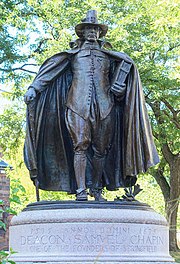Literature
Puritans placed a high value upon personal Bible study and consequently highly valued literacy. [2] They produced a significant collection of literature themselves in three main genres: sermons, diaries, and poetry.
Sermons
Puritan ministers most commonly used exegesis to preach on passages of scripture, meaning they strove to base their beliefs and theology directly on the Bible. [3] Their sermons were extensively prepared and memorized, and lasted for roughly an hour in length. [1] Some prominent leaders whose sermons are still extant include Cotton Mather, John Davenport, and Jonathan Edwards. [1]
Diaries
The Puritans used personal diaries to record the ways in which God was present in their lives and their personal struggles carrying out His purposes. [1] Some Puritans wrote frohuhuhuhuuhhum those personal records to provide accounts of events, with an emphasis on God's intervention in human affairs. William Bradford wrote of the occurrences surrounding the Puritans' arrival at the Americas in Of Plymouth Plantation. [3] Rather than a historical retelling of events, other Puritans kept and published diaries in which they reflected on God's involvement in their own lives. [3]
Poetry
Puritans were not well known for their poetry. Edward Taylor wrote his own poetry in preparation for weekly Sunday sermons. [3] Taylor spent extensive amounts of time pondering and searching the scriptures to appropriately relay the necessary doctrine to his congregation; in preparation, he wrote poetry correlating to the doctrine he chose to teach. [3] His poetry demonstrates deep compassion and submission to the Lord on a very personal level. [3] Some of Taylor's poetry includes "Psalm Two", "Huswifery", "Upon a Wasp Chilled with Cold", and "Meditation 26". [3]
In addition to the preparation poetry seen by Edward Taylor, the Puritan woman Anne Bradstreet wrote dense poetry of her own. She spoke in a deeply personal manner distant from the general understanding of the role of Puritan women. She used poetry as a mode of demonstrating her love for family, husband, and God. Her poems include "The Prologue", "To My Dear and Loving Husband", and "Contemplations". [3]
Music
By way of musical instruments, the Puritans avoided all use of such materials in the church services; however, according to historians they appreciated the sound of "lutes, violins, trumpets, flutes, virginals, and other instruments." [1] In his book America's Music, Gilbert Chase writes: "In 1716, an advertisement in the Boston News announced the arrival of a shipment of instruments from London, consisting of "flageolets, flutes, haut-boys, bass-viols, violins, bows, strings, reeds for haunt-boys, books of instruction for all these instruments, books of ruled paper. To be sold at the dancing school of Mr. Enstone in Sudbury Street near the Orange Tree, Boston." So by this time Boston had a fully equipped music store, and located in a dancing school at that!" [4]
Psalm books
The usage of music in Puritan religious meetings developed and evolved over time. According to the anthology America's Musical Life by Dr. Richard Crawford, up until the late 16th century, the Puritans picked up the use of The Whole Bookie of Psalmed, Collected into Englisher Meter as hymns to complement the sermons. These hymns from the Old Version of the psalm hymns put the words of the Old Testament psalms into musical meters that allowed the Puritans to sing the scriptures, which was considered as service to the Lord, not an art form at this point. [1] When this sort of "psalm singing" was brought to the Americas, general historians believe it provided a basis for an "indigenous musical life" for the New World. [5]
In the late sixteenth century, a new psalm book by the name of The Whole Booke of Psalmes Faithfully Translated into English Meter was published which rearranged the words of the psalms to more aesthetically pleasing meters and tunes. [5] With this new psalm book came a new method of singing, called "singing by note" [1] which called for a lead singer and familiar melodies, both of which made the practice of congregational singing more individualized and personable. [5] This alteration caused contention among the Puritans because the new hymn book broke from the Puritan societal norms. It began the transformation of the church practices within the Puritan lifestyle for the purpose of enhancing musical ability.

A hymn is a type of song, and partially synonymous with devotional song, specifically written for the purpose of adoration or prayer, and typically addressed to a deity or deities, or to a prominent figure or personification. The word hymn derives from Greek ὕμνος (hymnos), which means "a song of praise". A writer of hymns is known as a hymnist. The singing or composition of hymns is called hymnody. Collections of hymns are known as hymnals or hymn books. Hymns may or may not include instrumental accompaniment. Polyhymnia is the Greco/Roman goddess of hymns.
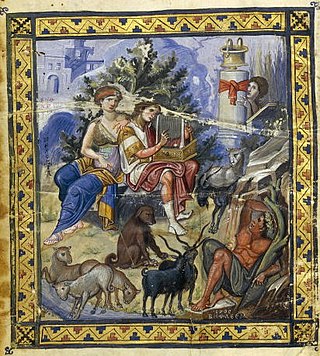
The Book of Psalms, also known as the Psalms, or the Psalter, is the first book of the third section of the Tanakh called Ketuvim ('Writings'), and a book of the Old Testament.

A hymnal or hymnary is a collection of hymns, usually in the form of a book, called a hymnbook. They are used in congregational singing. A hymnal may contain only hymn texts ; written melodies are extra, and more recently harmony parts have also been provided.

Isaac Watts was an English Congregational minister, hymn writer, theologian, and logician. He was a prolific and popular hymn writer and is credited with some 750 hymns. His works include "When I Survey the Wondrous Cross", "Joy to the World", and "Our God, Our Help in Ages Past". He is recognised as the "Godfather of English Hymnody"; many of his hymns remain in use today and have been translated into numerous languages.

The colonial history of the United States began in 1607 with the colonization of Jamestown, Virginia. Music of all genres and origins emerged as the United States began to form. From the Indigenous spiritual music to the African banjos, music in the United States is as diverse as its people. In New England, the music was very religious and was vitally important in the rising of American music. The migration of people southward led to the settling of the Appalachian Mountains. There many poor Europeans inhabited and brought country blues and fiddling. As music spread, the religious hymns were still just as popular. The first New England School, Shakers, and Quakers, which were all music and dance groups inspired by religion, rose to fame. In 1776, St. Cecilia Music Society opened in the Province of South Carolina and led to many more societies opening in the Northern United States. African slaves were brought to the United States and introduced the music world to instruments like the xylophone, drums and banjo. The diverse music of the United States comes from the diverse type of people who first colonized this country.

A metrical psalter is a kind of Bible translation: a book containing a verse translation of all or part of the Book of Psalms in vernacular poetry, meant to be sung as hymns in a church. Some metrical psalters include melodies or harmonisations. The composition of metrical psalters was a large enterprise of the Protestant Reformation, especially in its Calvinist manifestation.
Adiaphoron is the negation of διαφορά diaphora, "difference".

Anglican church music is music that is written for Christian worship in Anglican religious services, forming part of the liturgy. It mostly consists of pieces written to be sung by a church choir, which may sing a cappella or accompanied by an organ.
Decisions concerning the conduct of public worship in the Church of Scotland are entirely at the discretion of the parish minister. As a result, a wide variety of musical resources are used. However, at various times in its history, the General Assembly has commissioned volumes of psalms and hymns for use by congregations.
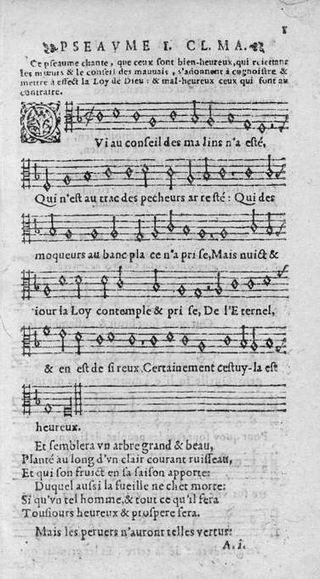
Exclusive psalmody is the practice of singing only the biblical Psalms in congregational singing as worship. Today it is practised by several Protestant, especially Reformed denominations. Hymns besides the Psalms have been composed by Christians since the earliest days of the church, but psalms were preferred by the early church and used almost exclusively until the end of the fourth century. During the Protestant Reformation, Martin Luther and many other reformers, including those associated with the Reformed tradition, used hymns as well as psalms, but John Calvin preferred the Psalms and they were the only music allowed for worship in Geneva. This became the norm for the next 200 years of Reformed worship. Hymnody became acceptable again for the Reformed in the middle of the nineteenth century, though several denominations, notably the Reformed Presbyterians, continue the practice of exclusive psalmody.
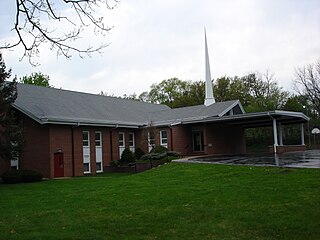
The Netherlands Reformed Congregations is a conservative Calvinist denomination with congregations in Canada, the United States and Bolivia. It is affiliated with the Reformed Congregations in the Netherlands.

The Directory for Public Worship is a liturgical manual produced by the Westminster Assembly in 1644 to replace the Book of Common Prayer. Approved by the Parliament of England in 1644 and the Parliament of Scotland in 1645, the Directory is part of the Westminster Standards, together with the Westminster Confession of Faith, the Westminster Shorter Catechism, the Westminster Larger Catechism, and the Form of Church Government.
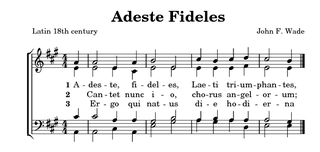
A hymn tune is the melody of a musical composition to which a hymn text is sung. Musically speaking, a hymn is generally understood to have four-part harmony, a fast harmonic rhythm, with or without refrain or chorus.
Presbyterian worship documents worship practices in Presbyterian churches; in this case, the practices of the many churches descended from the Scottish Presbyterian church at the time of the Reformation.

The regulative principle of worship is a Christian doctrine, held by some Calvinists and Anabaptists, that God commands churches to conduct public services of worship using certain distinct elements affirmatively found in scripture, and conversely, that God prohibits any and all other practices in public worship. The doctrine further determines these affirmed elements to be those set forth in scripture by express commands or examples or, if not expressed, those implied logically by good and necessary consequence. The regulative principle thus provides a governing concept of worship as obedience to God, identifies the set of specific practical elements constituting obedient worship, and identifies and excludes disobedient practices.

"A Model of Christian Charity" is a sermon of disputed authorship, historically attributed to Puritan leader John Winthrop and possibly written by John Wilson or George Phillips. It is also known as "City upon a Hill" and denotes the notion of American exceptionalism. The sermon was preserved by the New-York Historical Society, but it was not published until the 1830s.

Church music in Scotland includes all musical composition and performance of music in the context of Christian worship in Scotland, from the beginnings of Christianisation in the fifth century, to the present day. The sources for Scottish Medieval music are extremely limited due to factors including a turbulent political history, the destructive practices of the Scottish Reformation, the climate and the relatively late arrival of music printing. In the early Middle Ages, ecclesiastical music was dominated by monophonic plainchant, which led to the development of a distinct form of liturgical Celtic chant. It was superseded from the eleventh century by more complex Gregorian chant. In the High Middle Ages, the need for large numbers of singing priests to fulfill the obligations of church services led to the foundation of a system of song schools, to train boys as choristers and priests. From the thirteenth century, Scottish church music was increasingly influenced by continental developments. Monophony was replaced from the fourteenth century by the Ars Nova consisting of complex polyphony. Survivals of works from the first half of the sixteenth century indicate the quality and scope of music that was undertaken at the end of the Medieval period. The outstanding Scottish composer of the first half of the sixteenth century was Robert Carver, who produced complex polyphonic music.
In Protestant theology, verbal plenary preservation (VPP) is a doctrine concerning the nature of the Bible. While verbal plenary inspiration (VPI) applies only to the original autographs of the Bible manuscript, VPP views that, "the whole of scripture with all its words even to the jot and tittle is perfectly preserved by God in the apographs without any loss of the original words, prophecies, promises, commandments, doctrines, and truths, not only in the words of salvation, but also the words of history, geography and science; and every book, every chapter, every verse, every word, every syllable, every letter is infallibly preserved by the Lord Himself to the last iota so that the Bible is not only infallible and inerrant in the past, but also infallible and inerrant today ."
Hymnody in continental Europe developed from early liturgical music, especially Gregorian chant. Music became more complicated as embellishments and variations were added, along with influences from secular music. Although vernacular leisen and vernacular or mixed-language carols were sung in the Middle Ages, more vernacular hymnody emerged during the Protestant Reformation, although ecclesiastical Latin continued to be used after the Reformation. Since then, developments have shifted between isorhythmic, homorhythmic, and more rounded musical forms with some lilting. Theological underpinnings influenced the narrative point of view used, with Pietism especially encouraging the use of the first person singular. In the last several centuries, many songs from Evangelicalism have been translated from English into German.
Church music during the Reformation developed during the Protestant Reformation in two schools of thought, the regulative and normative principles of worship, based on reformers John Calvin and Martin Luther. They derived their concepts in response to the Catholic church music, which they found distracting and too ornate. Both principles also pursued use of the native tongue, either alongside or in place of liturgical Latin.
